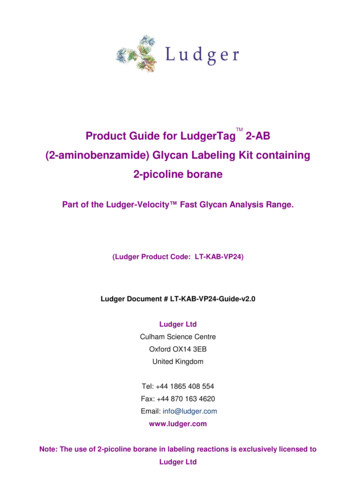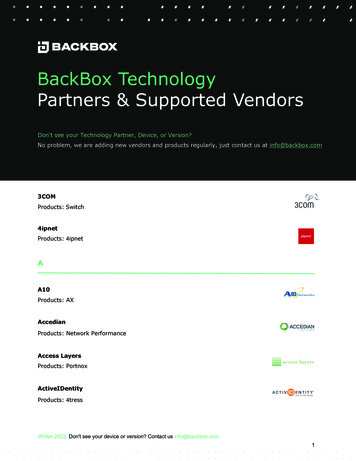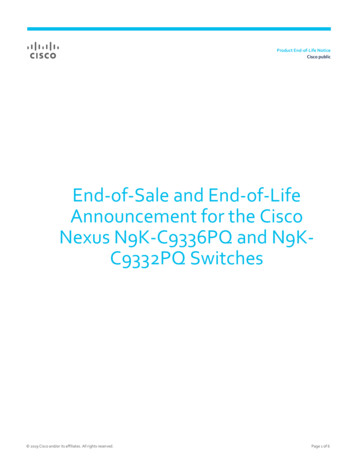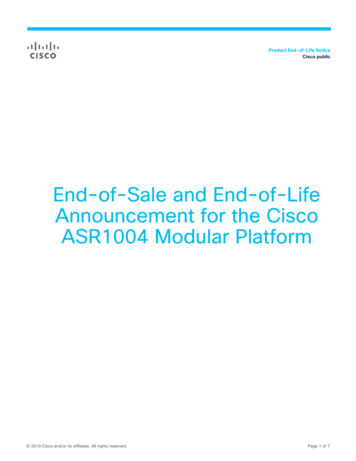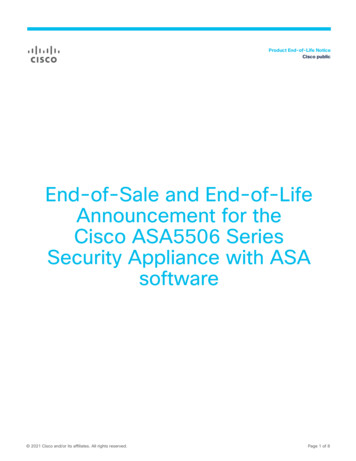
Transcription
Advanced Glycan End Products (AGE) andDiabetes: Cause, Effect, or Both?
NIH Public AccessAuthor ManuscriptCurr Diab Rep. Author manuscript; available in PMC 2015 January 01.NIH-PA Author ManuscriptPublished in final edited form as:Curr Diab Rep. 2014 January ; 14(1): 453. doi:10.1007/s11892-013-0453-1.Advanced Glycation End Products (AGE) and Diabetes: Cause,Effect, or Both?Helen Vlassara, MD1,2 and Jaime Uribarri, MD21Department of Geriatrics, Mount Sinai School of Medicine, New York, NY2Departmentof Medicine, Mount Sinai School of Medicine, New York, NYAbstractNIH-PA Author ManuscriptDespite new and effective drug therapies, insulin resistance (IR), type 2 diabetes mellitus (T2D)and its complications remain major medical challenges. It is accepted that IR, often associatedwith over-nutrition and obesity, results from chronically elevated oxidant stress (OS) and chronicinflammation. Less acknowledged is that a major cause for this inflammation is excessiveconsumption of advanced glycation end products (AGEs) with the standard western diet. AGEs,which were largely thought as oxidative derivatives resulting from diabetic hyperglycemia, areincreasingly seen as a potential risk for islet β-cell injury, peripheral IR and diabetes.Here we discuss the relationships between exogenous AGEs, chronic inflammation, IR, and T2D.We propose that under chronic exogenous oxidant AGE pressure the depletion of innate defensemechanisms is an important factor, which raises susceptibility to inflammation, IR, T2D and itscomplications. Finally we review evidence on dietary AGE restriction as a non-pharmacologicintervention, which effectively lowers AGEs, restores innate defenses and improves IR, thus,offering new perspectives on diabetes etiology and therapy.KeywordsAGE-Receptors; AGER1; SIRT1; Glycation; Oxidation; Diet; Inflammation; Innate Immunity1. IntroductionNIH-PA Author ManuscriptAs the incidence of type 2 diabetes (T2D) continues to increase [1] and its multifactorialetiology is still debated, new evidence points to lifestyle factors as critical predisposingfactors [2, 3]. T2D as well as obesity are characterized by chronic inflammation and insulinresistance (IR), associated with chronically elevated oxidant stress (OS).The importance of hyperglycemia in the pathogenesis of diabetic complications has beenreinforced by clinical trials [4, 5] although more recent studies [6–8] point to additional riskCorrespondence: Jaime Uribarri, MD, Mount Sinai School of Medicine, One Gustave Levy Place, Box 1147; phone: 212-241-1887;jaime.uribarri@mssm.edu.Conflict of InterestHelen Vlassara has received grant support and support for travel to meetings for the study or otherwise from Sanofi for a coinvestigator-initiated clinical investigation. She has patents (planned, pending or issued) from Cell Biolabs for development ofmonoclonal antibody, and receives royalties for monoclonal antibody. Her husband is principal investigator in investigator-initiatedclinical trial, supported by Sanofi.Jaime Uribarri is a co-author on a book on AGE-less Diet.Human and Animal Rights and Informed ConsentThis article does not contain any studies with human or animal subjects performed by any of the authors.
Vlassara and UribarriPage 2NIH-PA Author Manuscriptfactors. For instance, one way for hyperglycemia to cause cell injury is by fosteringadvanced glycation end products (AGEs). These are known to contribute to thecomplications of diabetes by raising intracellular oxidative stress (OS) [9–11]. Compellingepidemiological evidence suggests that elevated AGEs may be a significant risk factor fortype 1 diabetes [12], for beta cell injury [13–16] and for peripheral IR [17, 18]. Thisevidence begs the question of the origin of the large concentrations of AGEs that couldinduce beta cell toxicity prior to diabetes onset. New studies have introduced an instructiveview proposing that the abundance of pro-oxidant AGEs in the highly industrialized modernfood environment could potentially account for the initiation and progression of pre-diabetesto diabetes [19].2. High Systemic AGEs – Not Always From High GlucoseNIH-PA Author ManuscriptAmong naturally occurring reducing sugars, glucose exhibits the slowest glycation rate,unlike fructose, glucose-6-phosphate or glyceraldehyde-3-phosphate, which areintracellularly present at small levels, but can form AGEs at a faster rate, especially underhigh temperatures, i.e. ex vivo [20]. The chemical transformation of amine-containingmolecules by reducing sugars—whether on proteins, lipids or nucleotides [21]—results inAGEs or Maillard products. Since high OS triggers the formation of dicarbonyl derivativesor AGEs it follows that diabetes and conditions of chronic high OS will further acceleratethis spontaneous process. Several well studied AGEs, such as carboxymethyllysine (CML),pentosidine, or derivatives of methylglyoxal (MG), i.e. MG-H1, are among the bettercharacterized AGE compounds, currently serving as AGE markers [19, 22].It has now become evident that even in the absence of diabetes, AGEs can be introducedinto the circulation together with nutrients processed by common methods such as dry heat[23] or during tobacco smoking [24]. Food processing, involving dry heat, ionization orirradiation, whether at the industrial or commercial levels, significantly accelerates thegeneration of new AGEs [25, 26]. Heat and dehydration are also common in home cooking.Such simple methods, though intended to improve safety, digestibility and transportability offoods, can amplify the formation of AGEs. For the food industry, AGEs in food are highlydesirable, due to the profound effect of AGEs on food flavor, and hence on foodconsumption [27].NIH-PA Author ManuscriptHuman and animal studies demonstrated that about 10% of AGEs contained in a meal canbe absorbed into the circulation, of which two thirds remain in the body for 72 hours[23,28], long enough to promote OS, more AGEs and potentially tissue injury. CommonAGEs, such as CML, MG-derivatives and others are thought as capable of inducinginflammatory events [26]. Since the effects of both, exogenous and endogenous AGEs canbe directly or indirectly blocked by anti-oxidants and anti-AGE agents [26], they haveoverlapping biological properties.Among healthy subjects the daily intake of AGEs during regular meals is estimated to beexcessive beyond a range compatible with low levels of inflammatory markers. We havedefined a high- or low-AGE diet on whether the estimated dietary AGE intake is greater orlower than 15,000 AGE kU/day, which happens to be the median dietary AGE intake in ourcohort of healthy community dwellers [29,30]. This is largely attributed to the fact that mostfavored methods of food preparation promote AGE formation. On a chronic basis,consumption of high AGE foods can cause a strain upon, and eventually a depletion ofnative anti-oxidant defenses, setting the stage for disease, i.e. diabetes. A prematurecompromise or else an inability to mount sufficient innate anti-oxidant defenses mayaccount for the fact that high serum AGE levels in mothers closely correlated with those oftheir newborns. Moreover, high serum AGEs in mothers predict higher plasma insulin orCurr Diab Rep. Author manuscript; available in PMC 2015 January 01.
Vlassara and UribarriPage 3NIH-PA Author ManuscriptHOMA levels, but lower adiponectin levels [31] during the first year of life, factors whichmay pre-condition infants, with or without genetic predisposition, to diabetes. In thiscontext, crucial epidemiological evidence has emerged identifying high levels of circulatingAGEs as a risk factor for developing T1D both, in ICA (islet cell autoantibodies) twin aswell as in non-twin cohorts [12], which highlighted the evidently important question of theorigin of high AGE levels prior to diabetes and at a young age.Based on semiquantitative but well-validated immune assays new information on the AGEcontent of common foods [29, 30] have began to illustrate that dry heat-involving foodprocessing methods (typically broiling, searing, and frying) significantly increase thecontent of protein, as well as lipid-related AGEs in foods, especially those of animal origin,unlike methods that utilize lower temperatures and more moisture or water (as in stewing,steaming, boiling). The same amount or type of nutrient, such as protein or fat, candramatically influence the amount of glycoxidants delivered if prepared under dry-heat, theburden of which can lead to depleted defenses (Figure 1). At the same time, practical toolshave been developed for assessing dietary AGE intake, or for adjusting diets to a lower AGEcontent, while maintaining optimal caloric and nutrient intake [29].3. Are AGEs Diabetogenic Agents? Mice studiesNIH-PA Author ManuscriptExtensive evidence demonstrates that AGEs can cause tissue injury, directly linking them tolong-term diabetic complications [2, 9–11]. Moreover, recent findings have shed new lightsuggesting that exogenous AGEs may actually cause reduced peripheral insulinresponsiveness [12, 32, 33]. Studies of primary adipocytes from trans-generational miceexposed for life to specific AGEs, such as MG-albumin - added to a low AGE diet at levelsmatching those in a standard mouse chow-showed that sustained exposure to glycoxidantscan alter insulin receptor and IRS-1 phosphorylation levels and pattern, leading to impairedglucose-uptake, or fat mobilization from adipose tissue [32]. Another noteworthy findingwas that, by the fifth generation, MG-fed mice developed insulin resistance as early as 16–18 months of age, instead of 24–26 months of age seen in the regular chow-fed controls. TheAGE-restricted cohort did not develop these changes until beyond the age of 36 months or atime interval corresponding to approximately 20 human years [32]. These findings havebegun to shift prior dogmas and introduce the view that prolonged exposure to an oxidantforce that normally does not exist in nature, over the span of several generations, can depleteinnate immune defenses, thus miss-firing inflammatory responses or fostering metabolicdefects, namely in insulin action. This view, while prompting further investigation intopotential epigenetic changes, has begun to receive support in the clinical setting, as isdiscussed later [19, 22, 23].NIH-PA Author ManuscriptSeveral well-controlled animal studies have suggested that AGEs are also involved in isletβ-cell damage in both T1D and T2D. Restriction of external AGEs protected and maintainednormal pancreatic islet morphology and function in diverse models of diabetes, whether ofgenetic i.e. non-obese diabetic (NOD) mice susceptible to autoimmune T1D or db/db / mice prone to T2D [13, 14] (Figure 2), or non-genetic etiology, i.e. dietary fat-induced orage-related diabetes [15, 17]. Subsequent data assigned AGE-mediated β-cell toxicity to theinhibition of cytochrome-c oxidase and reduced ATP production, thus impairing insulinsecretion [13, 34, 35]. AGEs can also promote immune cell (T-cell, macrophage)recruitment, activation and beta cell cytotoxicity, apoptosis or cell death. AGER1 normallysuppresses the effects of AGEs and ROS, and may enhance SIRT1 expression and functionin beta cells, positively regulating insulin secretion (Figure 3). However under chronic highlevel AGE conditions, AGER1, SIRT1 and other defenses are downregulated, thus possiblycontributing to beta cell dysfunction or destruction. An AGE inhibitor, aminoguanidine(AG) [34] protected islet beta cell function both in vivo and in isolated rat islet [34,35].Curr Diab Rep. Author manuscript; available in PMC 2015 January 01.
Vlassara and UribarriPage 4NIH-PA Author ManuscriptOther animal studies have expanded the mechanistic basis of these findings and togetherdemonstrated that excessive AGEs have the potential of acting as diabetogenic agents in theproper context [36].4. Diet-derived AGEs and Human HealthHigh AGE levels in T2D patients had been attributed to endogenous sources, namelyhyperglycemia and OS [9] until it was noted that non-diabetic persons too could have“diabetic” levels of serum AGEs and OS, if they consumed a diet with a high AGE content[19, 22]. In pursuing this further, it was noted that unlike previous dogma, serum AGEscorrelated with dietary AGE intake, as well as with established markers of OS andinflammation, such as hsCRP and TNFα, independent of age or diabetes [19, 22]. In selfdeclared normal controls from our population a significant association with HOMA, anindicator of IR, was also noted suggesting that the standard western diet could serve as aconstant source of oxidants (Figures 4A,B). This, if supported by larger trials, may provecritical for those subjects with “non-obese” BMI who consume excessive AGEs as thesemay raise their risk for the metabolic syndrome or T2D.NIH-PA Author ManuscriptOther studies reported lowered levels of serum AGEs in diabetic patients after two monthson a low-AGE diet [37]. This and other studies involving subjects with or without diabetesor with chronic kidney disease provide strong evidence that a low AGE diet program can behighly effective in reducing chronic OS and inflammation [22, 33, 37]. Together thesestudies bring into focus a new fact: the modern food environment can act as a significantsource of AGEs which are capable of altering native defenses and of disturbing anti-oxidantbalance in humans. Importantly, a dietary intervention, which utilizes a regimen of reducedAGE consumption, may represent a simple yet significant advance in the efficacy of antidiabetic therapies [33, 37].Another notable but unrecognized source of AGEs is cigarette smoking [24]. The processingor curing of tobacco involves AGE formation since the plant leaves are heat-dried in thepresence of reducing sugars, added for purposes such as taste and smell. Subsequentcombustion can lead to the inhalation of AGE derivatives and transfer into the circulation[24]. Levels of serum AGEs or LDL-apolipoprotein-B were found higher in chroniccigarette smokers than in nonsmokers. Also, AGE levels were higher in arterial wall samplesor ocular lenses in smokers with diabetes compared to those from non-smoking diabeticpersons [38]. Mechanistic and efficacy studies on smoking cessation have not beenconducted from this perspective.NIH-PA Author Manuscript5. AGE Balance: Keeping a Tide at BayAGE catabolism is dependent on tissue anti-oxidant reserves, macromolecular turnover andreceptor-mediated AGE degradation, prior to renal elimination. Steady-state AGE levelsreflect not only glycemia, but also the balance of oral intake, endogenous formation, andcatabolism of AGEs. At least two types of cellular AGE receptors have been characterized:RAGE and AGER1. AGER1 binds, degrades AGEs and protects against oxidant injury(Figure 5). It has considerable anti-oxidant and anti-inflammatory properties based onstudies on AGER1-transduced cells and transgenic mice [22, 39–42]. AGEs induce nativeAGER1. Prolonged supply of external AGEs, however, depletes AGER1. The ensuingsurplus OS promotes inflammation via RAGE, TLR4, EGFR and other receptors regulatingthe activities of NF-κB, AP1, FOXO and other pathways. Chronically elevated AGEs, viahigh OS, are potent suppressors of NAD , partly by reducing NAMPT leading to SIRT1depletion. Decreased SIRT1 levels promote NF-κB p65 hyper-acetylation and enhancedtranscription of inflammatory genes, such as TNFα, which contributes to insulin resistance.AGER1, by engaging AGEs, controls many of these effects. The protective effects ofCurr Diab Rep. Author manuscript; available in PMC 2015 January 01.
Vlassara and UribarriPage 5AGER1 may stem from its long extracellular tail with high-affinity AGE-binding domainthat competitively interferes with other AGE cell surface interactions leading to ROS.NIH-PA Author ManuscriptThe other type of multi-ligand receptor, RAGE is thought to promote and perpetuate cellactivation and tissue injury via increased OS [43]44. The balance between these tworeceptors may be critical in the maintenance of oxidant homeostasis or progression todiabetes. Thus, AGER1 disrupts RAGE signaling [39] and promotes the expression andfunctions of SIRT1, a major deacetylase and a regulator of inflammation and the metabolicactions of insulin [32]. AGER1, like SIRT1 and other defense mechanisms, is suppressed inchronic diabetes. However both AGER1 and SIRT1 are restored after lowering the externaloxidant burden by AGE restriction [32, 33]. Taken together, AGER1 expression levelscorrelate positively with the levels of other intracellular anti-oxidant mechanisms (SIRT1,NAMPT, SOD2, GSH) and negatively with pro-oxidant pathways (i.e, RAGE, NADPHoxidase, p66shc). Thus, assuming that AGER1 is important in the maintenance of normalAGE homeostasis, reduced AGER1 expression levels may signal a compromise in hostdefenses.NIH-PA Author ManuscriptDegradation products of AGE-proteins resulting from the action of AGER1 and otherreceptor or non-receptor mechanisms give rise to AGE-peptides, which normally filteracross the glomerular membrane. After filtration they can undergo variable degrees oftubular reabsorption or further catabolism by the proximal tubule, and excretion in the urine[45]. The active participation of the kidneys in the metabolism and excretion of AGEs isdemonstrated by an inverse correlation between serum AGE levels and renal functionestimated by glomerular filtration rate (GFR) [46]. A precise and quantitative analysis of thecontribution of each of these processes is lacking in humans. It is, however, suggested inboth animal and human studies, that even a modest degree of renal disease is associated witha markedly reduced excretion of oxidant AGEs [23, 46, 47].6. Failing anti-AGE Defenses: a Road to High OS and Chronic InflammationNIH-PA Author ManuscriptAmbient levels of AGEs and OS regulate the expression of both AGER1 and RAGEreceptors and their downstream pathways as needed to maintain the glycoxidative balancewithin cells. Thus, short-term elevations in AGEs can bring about an overexpression inAGER1, as well as in RAGE levels. On the other hand, reduced AGE levels, as seen after alow AGE diet in healthy subjects, downregulate AGER1 as well as RAGE levels [22].Consistent with an active role of AGER1 in AGE turnover and elimination by the normalkidney, AGER1, but not RAGE levels correlate directly with urinary AGEs in healthypersons. Under chronic diabetes or chronic kidney disease, however, the situation is quitedifferent. RAGE levels remain high, while AGER1 levels are uniformly suppressed evenduring full anti-diabetic therapy [18, 22, 33], indicating persistently high OS. However,when diabetic patients followed a low-AGE diet for 4 months, AGER1 levels were restoredto normal, while RAGE levels were effectively suppressed [33]. This pattern furthersuggests that a functional depletion of AGER1 could be important in diabetic tissue injury asit could lead to intracellular AGE accumulation, ROS generation, and suppression of NAD -dependent SIRT1, followed by a further increase in pro-inflammatory NF-κB activity.Thus a hyper-activation of RAGE and other pro-inflammatory genes could be theconsequence of a failure of anti-AGE and anti-OS defenses, such as AGER1 and SIRT1, tofend off perpetual OS.From the clinical and animal studies available, it may also be concluded that innate defensesand anti-oxidant mechanisms can be rapidly bolstered by the effective reduction of externaloxidants, rather than by adding anti-oxidant supplements, which though perfectly functional,may be insufficient compared to the magnitude of their targets.Curr Diab Rep. Author manuscript; available in PMC 2015 January 01.
Vlassara and UribarriPage 67. Diabetes, Diabetic Complications and the New ParadoxNIH-PA Author ManuscriptBecause hyperglycemia has traditionally been thought to be the principal source of AGEs,intensive control of hyperglycemia was expected to also control the consequences of AGEson diabetic vascular complications [4, 48]. Recently conducted large studies (ACCORD,ADVANCE, NADT) [6–8] have, however, failed to produce these long-anticipated resultshighlighting a need to identify new precipitating factors. For instance, measures to assessand modulate exogenously derived AGEs might have influenced these results. Furthermore,well-controlled cellular and animal studies suggest that a chronic exogenous overload ofoxidant AGEs can incite β-cell injury [13] and thus the occurrence of T1D and T2D diabetesand their complications [49].NIH-PA Author ManuscriptThe contributing role of AGEs in human diabetes, but also in human non-diabetes relatedCVD or CKD is fairly well established [50–53]. A significant correlation was previouslyfound between circulating AGE-apoB levels, vascular tissue AGEs and severity ofatherosclerotic lesions in non-diabetic patients with coronary artery occlusive disease [49],and in diabetic subjects with aortic stiffness 53]. Serum pentosidine has also been shown tocorrelate positively with heart-brachial pulse wave velocity and with carotid intima-mediathickness [54] in patients with T2D. In a random sample of Finnish T2D participantsfollowed for 18 years serum levels of AGEs were associated with total and CVD mortalityin women [55]. These studies reinforce the role of AGEs in diabetic complications, apartfrom that of hyperglycemia. When patients with either type 1 or 2 diabetes were placed on alow AGE diet for a brief period of 6 weeks, there was a significant reduction of markers ofinflammation and endothelial dysfunction such as hsCRP, TNF and VCAM-1, in addition tomarkedly lower serum AGE levels [37].NIH-PA Author ManuscriptThe suggestion that food-derived AGEs could pose risk not only for diabetic vasculardisease, but diabetes per se, has introduced a new paradox, whereby hyperglycemia could bethe downstream effect of excessive AGEs, not a pre-requisite. Thus, in a study on T2Dsubjects, baseline serum AGEs were shown to correlate with fasting insulin, HOMA-IR andBMI and after a 4-month treatment with an AGE-restricted diet, a significant reduction inplasma insulin and leptin were associated with a marked rise in adiponectin [33], consistentwith improved insulin sensitivity. There were also significant increases in AGER1 andSIRT1 levels tied to reduced mononuclear cell NF-κB activity and decreased TNFα levels,all consistent with suppressed inflammation in these subjects. These findings awaitconfirmation in larger trials, but, since they were independent of any changes in standardmedical therapy, they support the postulate that the externally derived pro-inflammatoryAGEs are an important culprit [22, 33]. Furthermore, these abnormalities can be effectively- and economically - modulated by a modest decrease ( 50%) of the amount of AGEs in thediet, without changes in nutrients or calories.That dietary AGEs could also have a direct and immediate impact on tissues, such as thevasculature, was suggested in separate studies. An oral AGE challenge test produced anincrease in serum AGEs, followed by a transient endothelial dysfunction, based on impairedflow mediated dilatation or FMD, and a marked rise in plasminogen activator inhibitor-1 orPAI-1 - in both diabetic and non-diabetic subjects [56]. The test beverage contained neithercarbohydrates nor lipids, either of which could contribute to postprandial endothelialdysfunction. Finally, a single AGE-rich solid meal induced a more pronounced acuteimpairment of vascular function in diabetic subjects than did an otherwise nutritionallyidentical low-AGE meal [57]. The transient AGE effects shown by these studiesunderscored the possibility that repeated or sustained “stress” from the frequent intake ofcertain AGE-laden foods or beverages - apart from an excess of glucose or lipids - could setthe stage for long-term vascular and other tissue injury.Curr Diab Rep. Author manuscript; available in PMC 2015 January 01.
Vlassara and UribarriPage 78. Lifestyle Changes and Oral Agents that Can Prevent AGE Formation andAGE Gastrointestinal AbsorptionNIH-PA Author ManuscriptAfter consuming a meal with a high AGE content, healthy adults show a rapid absorption ofAGEs, with a rapidly rising peak in serum AGE level [23]. A close correlation was observedbetween AGEs consumed and AGEs in the circulation in a cross-section of healthy subjects[19]. Additional studies in healthy, diabetic or non-diabetic subjects with chronic renalinsufficiency showed that lowering dietary AGE intake (by 50%) could decreasecirculating AGE levels and markers of inflammation and OS [22, 37, 58]. More importantly,an otherwise isocaloric but low in AGE diet seems able of improving hyper-insulinemia (by 40%) in fully treated T2D patients, confirming that exogenous AGEs actively participate inthe metabolic dysfunctional milieu of T2D. A marked recovery was noted in levels ofAGER1, SIRT1 and adiponectin, three factors with anti-inflammatory properties, whichwere decreased at baseline. This return of innate defenses to normal suggests that thisstrategy carries promise as an efficient, low-cost treatment for those with diabetes mellitusor with prediabetes.NIH-PA Author ManuscriptOn the practical level, a low AGE intake can be easily achieved by using lower heat, higherhumidity (e.g. instead of roasting, grilling or frying, use stewing, poaching, etc) andavoiding highly processed pre-packaged and fast foods [29, 30]. Patients with diabetes havefound such a program to be easily incorporated into their personal and family life.Various inhibitors of post-Amadori glycation intermediates (glyoxal, methylglyoxal, 3deoxyglucosone) are described, including aminoguanidine [59–61], pyridoxamine,benfotiamine and ORB-9195 [62, 63]. Some of these, such as ORB-9195 may modulate thegeneration of glycation and lipoxidation derivatives [64, 65] and some may becomeavailable for clinical use in the future.Several authors have suggested the use of antioxidants as anti-AGE agents, i.e. vitamin E[66], N-acetylcysteine [67], taurine [68], alpha lipoic acid [69], penicillamine [70],nicanartine [71] and others, despite the disappointing results of a range of studies with oralantioxidants. Since previous trials did not consider the large exogenous oxidant surplusentering the gastrointestinal tract and likely neutralizing them, their failure may not besurprising. More studies with new agents and expanded range of dosages will be needed todefinitively establish their effectiveness [72, 73].NIH-PA Author ManuscriptIn this context, a new study introduced sevelamer carbonate, an oral non-absorbablenegatively charged polymer, known clinically for its phosphate-binding capacity [74]. Theagent, in addition to phosphates, can bind AGEs in a pH-dependent manner, and thuspossibly sequester AGEs in the gut. After 2 months, sevelamer carbonate, but not CaCO3,another phosphate-binder that does not bind AGEs, effectively lowered circulating AGEs, aswell as markers of OS and inflammation in diabetic subjects with chronic kidney disease[74]. Of particular interest was that the agent restored AGER1 and SIRT-1 to normal levels.This alternative strategy, while currently under further clinical investigation, by confirmingthe importance of reducing absorption of oral AGEs, provides critical support to AGErestriction and may offer an important adjunct treatment strategy.ConclusionsA major shift over the past half century is the enrichment of the food environment withAGEs, palatable pro-oxidant substances, which can promote both overnutrition and oxidantoverload. Sustained oxidant overload may overwhelm host defenses and lead to unopposedoxidant stress and chronic inflammation. These states can over time impair insulinCurr Diab Rep. Author manuscript; available in PMC 2015 January 01.
Vlassara and UribarriPage 8NIH-PA Author Manuscriptproduction and/or sensitivity and lead to diabetes. The fact that AGEs contributesignificantly to OS and inflammation in diabetes and diabetic complications is no longerdebated. Hyperglycemia is a significant driving force for AGE formation, especially since itarrives upon a premise of pre-existing overt OS. It is becoming increasingly clear, however,that the common diet is a carrier of pre-formed AGEs, and thus, may be a key initiator orcontributor to OS. This causal factor is of particular concern in subjects not only withdiabetes but those with pre-diabetes. Thus, AGE overload as a cause of diabetes is an area ofmajor clinical relevance. While many pharmacologic anti-AGE therapies are underdevelopment, their efficacy remains to be proven. Aiming to reduce both the exogenous orfood-derived AGEs in addition to or beyond lowering endogenous hyperglycemia-derivedAGEs seems to be a sound target for lasting benefits against diabetes and its complications.In the interim, screening for and advising those with high AGE markers or consumption maybe a first move in this direction that is worth considering.AcknowledgmentsThis work was supported by grants AG-23188 and AG-09453 (to H.V.) and from the National Institutes of Health,National Institute of Research Resources (Grant M01-RR-00071) to the General Clinical Research Center at MountSinai School of Medicine.NIH-PA Author ManuscriptReferencesNIH-PA Author Manuscript1. Amos AF, McCarty DJ, Zimmet P. The rising global burden of diabetes and its complications:estimates and projections to the year 2010. Diabet Med. 1997; 14 (Suppl 5):S1–85. [PubMed:9450510]2. Huebschmann AG, Regensteiner JG, Vlassara H, Reusch JE. Diabetes and advanced glycoxidationend products. Diabetes Care. 2006; 29:1420–32. [PubMed: 16732039]3. Ford ES, Giles WH, Mokdad AH. Increasing prevalence of the metabolic syndrome among U.S.Adults Diabetes Care. 2004; 27:2444–9.4. The effect of intensive treatment of diabetes on the development and progression of long-termcomplications in insulin-dependent diabetes mellitus. The Diabetes Contro
advanced glycation end products (AGEs). These are known to contribute to the complications of diabetes by raising intracellular oxidative stress (OS) [9–11]. Compelling epidemiological evidence suggests that elevated AGEs may be a significant risk factor for type 1 diabetes [12], for beta

